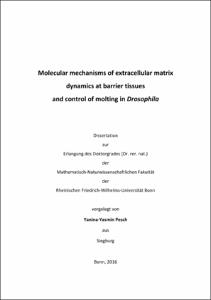Pesch, Yanina-Yasmin: Molecular mechanisms of extracellular matrix dynamics at barrier tissues and control of molting in Drosophila. - Bonn, 2017. - Dissertation, Rheinische Friedrich-Wilhelms-Universität Bonn.
Online-Ausgabe in bonndoc: https://nbn-resolving.org/urn:nbn:de:hbz:5n-47025
Online-Ausgabe in bonndoc: https://nbn-resolving.org/urn:nbn:de:hbz:5n-47025
@phdthesis{handle:20.500.11811/7175,
urn: https://nbn-resolving.org/urn:nbn:de:hbz:5n-47025,
author = {{Yanina-Yasmin Pesch}},
title = {Molecular mechanisms of extracellular matrix dynamics at barrier tissues and control of molting in Drosophila},
school = {Rheinische Friedrich-Wilhelms-Universität Bonn},
year = 2017,
month = apr,
note = {The insect epidermal cuticle acts as the exoskeleton and has crucial barrier functions, protecting against wounding, desiccation, invading pathogens and other environmental dangers. During the life of insects, the epidermal cuticle is periodically shed in a process called molting in order to adapt to increasing body growth. This requires coordinated cuticle rearrangement to reestablish the barrier functions. However, the molecular mechanisms of cuticle reorganization during molting and upon wounding are incompletely understood.
Two proteins were identified which have key roles in epidermal cuticle assembly in Drosophila larvae. First, the chitin-binding protein Obstructor-A (Obst-A) was shown to act as a central scaffold for cuticle organization. Obst-A builds a core complex of enzymes and proteins involved in the formation and protection of chitinous structures, which form a major part of the cuticle. Thereby Obst-A mediates the build-up of an organized, stable cuticle.
Second, the Chitinase 2 is essential for lamellar cuticle organization and was shown to be required for Obst-A function. Loss of both obst-A and Cht2 leads to similar defects in cuticle integrity and to death in larval stages. A structural analysis of the mutant larvae revealed that a prominent part of the cuticle, the chitin-matrix, is defective, leading to fragile cuticles at epithelial organs. On the molecular level, both Obst-A and Cht2 share an essential function in the so called cuticle assembly zone at the apical cell surface of epidermal cells. There, they contribute to proper chitin-matrix assembly and localization of enzymes and proteins that organize maturation and protection of newly synthesized cuticles.
In addition, Obst-A was shown to contribute to the hormonal control of molting in early larvae by influencing the production of the steroid molting hormone 20-hydroxyecdysone (20E). Obst-A is expressed in the hormone-producing cells of the ring gland. Loss of obst-A results in reduced size and severe malformation of this gland and impairment of upregulation of genes involved in 20E biosynthesis and signaling.
Altogether, new molecular factors in cuticle assembly and regulation of molting were characterized.},
url = {https://hdl.handle.net/20.500.11811/7175}
}
urn: https://nbn-resolving.org/urn:nbn:de:hbz:5n-47025,
author = {{Yanina-Yasmin Pesch}},
title = {Molecular mechanisms of extracellular matrix dynamics at barrier tissues and control of molting in Drosophila},
school = {Rheinische Friedrich-Wilhelms-Universität Bonn},
year = 2017,
month = apr,
note = {The insect epidermal cuticle acts as the exoskeleton and has crucial barrier functions, protecting against wounding, desiccation, invading pathogens and other environmental dangers. During the life of insects, the epidermal cuticle is periodically shed in a process called molting in order to adapt to increasing body growth. This requires coordinated cuticle rearrangement to reestablish the barrier functions. However, the molecular mechanisms of cuticle reorganization during molting and upon wounding are incompletely understood.
Two proteins were identified which have key roles in epidermal cuticle assembly in Drosophila larvae. First, the chitin-binding protein Obstructor-A (Obst-A) was shown to act as a central scaffold for cuticle organization. Obst-A builds a core complex of enzymes and proteins involved in the formation and protection of chitinous structures, which form a major part of the cuticle. Thereby Obst-A mediates the build-up of an organized, stable cuticle.
Second, the Chitinase 2 is essential for lamellar cuticle organization and was shown to be required for Obst-A function. Loss of both obst-A and Cht2 leads to similar defects in cuticle integrity and to death in larval stages. A structural analysis of the mutant larvae revealed that a prominent part of the cuticle, the chitin-matrix, is defective, leading to fragile cuticles at epithelial organs. On the molecular level, both Obst-A and Cht2 share an essential function in the so called cuticle assembly zone at the apical cell surface of epidermal cells. There, they contribute to proper chitin-matrix assembly and localization of enzymes and proteins that organize maturation and protection of newly synthesized cuticles.
In addition, Obst-A was shown to contribute to the hormonal control of molting in early larvae by influencing the production of the steroid molting hormone 20-hydroxyecdysone (20E). Obst-A is expressed in the hormone-producing cells of the ring gland. Loss of obst-A results in reduced size and severe malformation of this gland and impairment of upregulation of genes involved in 20E biosynthesis and signaling.
Altogether, new molecular factors in cuticle assembly and regulation of molting were characterized.},
url = {https://hdl.handle.net/20.500.11811/7175}
}






